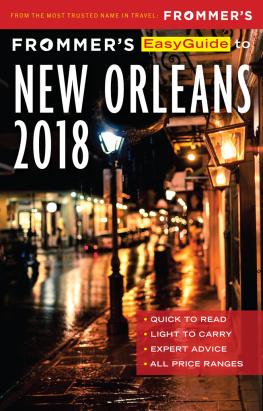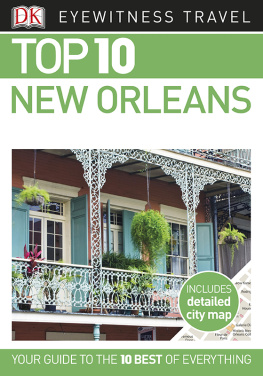
Copyright 2016 by Michael Murphy
Photographs copyright 2016 by Marc Pagani Photographymarcpagani.com, except where noted
Instrument icons made by Freepik from www.flaticon.com
All rights reserved.
For information about permission to reproduce selections from this book, write to Permissions, The Countryman Press, 500 Fifth Avenue, New York, NY 10110
For information about special discounts for bulk purchases, please contact W. W. Norton Special Sales at specialsales@wwnorton.com or 800-233-4830
The Countryman Press
www.countrymanpress.com
A division of W. W. Norton & Company, Inc.
500 Fifth Avenue, New York, NY 10110
www.wwnorton.com
The Library of Congress has cataloged the printed edition as follows:
Names: Murphy, Michael, 1954- author.
Title: Hear dat New Orleans : a guide to the rich musical heritage & lively current scene / Michael Murphy.
Description: Woodstock, VT : The Countryman Press, 2016. | Includes bibliographical references and index.
Identifiers: LCCN 2016001249 | ISBN 9781581573169 (pbk. : alk. paper)
Subjects: LCSH: Popular musicLouisianaNew OrleansHistory and criticism. | New Orleans (La.)Guidebooks.
Classification: LCC ML3477.8.N44 M87 2016 | DDC 780.9763/35dc23 LC record available at http://lccn.loc.gov/2016001249
ISBN 978-1-58157-582-8 (e-book)
My music is homegrown from the garden of New Orleans. Music is everything to me short of breathing. Music has a role to lift you upnot to be escapist but to take you out of misery.
Allen Toussaint

DEDICATION
Mere weeks after submitting the manuscript for Hear Dat, Allen Toussaint passed away after a concert in Madrid. He had earlier been gracious, as he was always gracious to everyone he met, to respond to my request to contribute to the Overture / Introduction of this book. I contacted my editor immediately that we had to make 11th-hour changes to the book or wed come off ridiculously uninformed or worse, horrendously calloused.
In death, Allen Toussaint felt irreplaceable. New Orleans carried a certain gloom that we had all lost something essential. We had. But one of the driving principles of Mr. Toussaints life was to build upon and carry on to a new generation the great tradition of New Orleans musicians like Professor Longhair and James Booker and that distinctively New Orleans weird rumba-boogie beat.
No one will ever be able to pull off styling socks and sandals the way Mr. Toussaint could, just as we wont see another Uncle Lionel strolling the streets resplendent in his many hats, walking canes, and watch draped across his hand, nor will there ever be a smile as bright as Louis Armstrongs. But their music lives on. Their music will touch, comfort, or energize listeners not yet born.
Dedicating this book is easy. To the musicians past, present, and future who inspire and are inspired by our music and who give New Orleans its essential and utterly unique soul.
Through pestilence, hurricanes, and conflagrations the people continued to sing. They sang through the long oppressive years of conquering the swampland and fortifying the town against the ever threatening Mississippi. They are singing today. An irrepressible joie de vivre maintains the unbroken thread of music through the air.
Lura Robinson
CONTENTS




Phtotographs in the Carol M. Highsmith Archive, Library of Congress, Prints and Photographs Division


New Orleans is the heart, soul, and music of America. Lenny Kravitz
S everal tales prevail as to where and how one of New Orleanss nicknames, the Big Easy, originated. Some assume it derives from the slow and easy way New Orleanians choose to live their lives. A New Orleans astrologer, Lynn Wilson, said of the city, New Orleanss value to the world lies in its charming dysfunctionality. The world doesnt need more Atlantas.
However, the most consistent and reliable derivation seems to come from back in the day, when musicians used to ride the rails looking for paying gigs in New York, Chicago, Memphis, and elsewhere. Musicians shared the sentiment that New Orleans was the #1 place to go. They tabbed the city the Big Easy because there were so many bars, clubs, dance halls, and juke joints that any halfway decent musician would always have an easy time finding work.
The same is true today. The first thing visitors often ask is, Where can I go to hear live music? A better question would be, Where can I go and not hear music? Music is everywhere in this city. It practically bubbles up from the streets, as famously claimed by Ellis Marsalis, jazz pianist and patriarch of the musical royal family in New Orleans.
From the time you wake up to a jazz brunch (and hear street musicians on the way there) until the last club closes along Frenchmen Street past three in the morning, live music will be as much a part of your day as eating, drinking, and buying things you dont need.
Music will accompany your meal at restaurants like Palm Court Jazz Caf, Little Gem Saloon, The Bombay Club, and Bacchanal, among many others. It will be played in your hotel lobby if you stay at The Columns Hotel, Hotel Monteleone, Irvin Mayfields Jazz Playhouse inside the Royal Sonesta, and the Davenport Lounge inside the Ritz-Carlton. At least four, sometimes five nights a week, you can go bowling while listening to some of the citys best musicians at the Rock n Bowl. The Grammy-nominated Dukes of Dixieland play nightly for the dinner cruise aboard the Steamboat Natchez.
Bars, juke joints, and clubs with live music number well over a hundred venues in New Orleans. Some spots, such as Tipitinas and Preservation Hall, are as famous as any musician who plays there. The amazing part is that even with the immense variety of options each night, and the weekly or thrice weekly appearance of any specific performer, the events are always sold out or standing room only. The Rebirth Brass Band fills Maple Leaf Bar every Tuesday night, as does The Hot 8 Brass Band every Sunday night at Howlin Wolf. On Mondays, Charmaine Neville gives two performances at 8:00 p.m. and again at 10:00 inside Snug Harbor. Unless shes touring, Best Female Singer each of the last four years, Meschiya Lake, can be seen and heard several times each week as she performs regularly at The Spotted Cat, Chickie Wah Wah, Little Gem Saloon, and The Bombay Club.
Most spots will have a modest cover charge, usually 5 to 10 dollars. But theres also plenty of extremely good free music available. Wednesday at the Square is a 12-week series in Lafayette Square showcasing both local and national performers. Once, prior to living here, I happened upon Buddy Guy playing as part of the Lafayette Square seriesfor free. There is, additionally, a nine-week series of free concerts called Jazz in the Park held on Congo Square in Louis Armstrong Park. And for a $2 fee you can take a 15-minute ferry ride across the Mississippi River and join the free music series, Wednesdays on the Point, June through August near the Algiers Ferry Landing.
Next page










